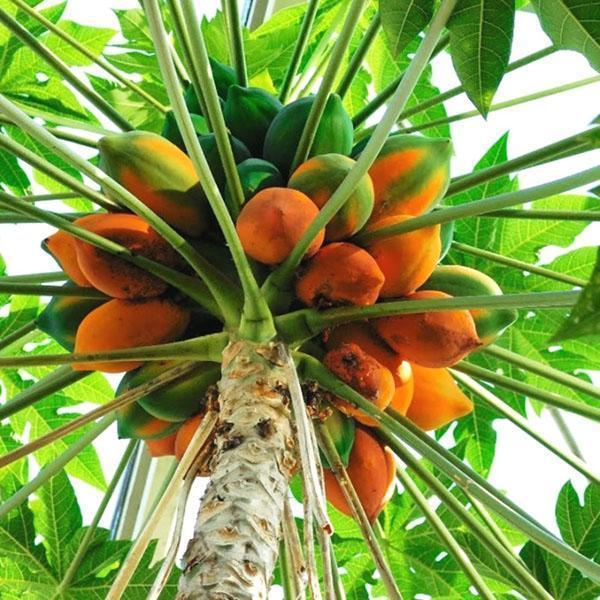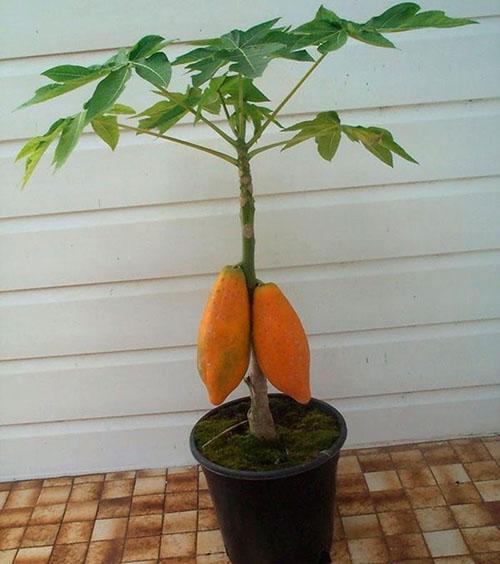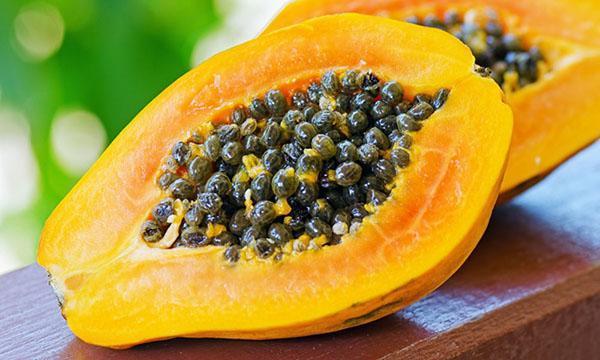Home care for a unique melon tree
 The melon tree or papaya, as it is also called, belongs to the karykovy family. Its homeland is the lands of tropical countries. Papaya is known all over the world for its aromatic and healthy fruits. They are often used to prepare fruit salads and desserts. Green berries are used as vegetables. Ripe fruits are very similar in appearance to a melon, and an enzyme called papain is extracted from the milk juice of the fruit. A photo of a melon tree and a description of its care are presented below.
The melon tree or papaya, as it is also called, belongs to the karykovy family. Its homeland is the lands of tropical countries. Papaya is known all over the world for its aromatic and healthy fruits. They are often used to prepare fruit salads and desserts. Green berries are used as vegetables. Ripe fruits are very similar in appearance to a melon, and an enzyme called papain is extracted from the milk juice of the fruit. A photo of a melon tree and a description of its care are presented below.
How to grow a tree from seeds


Rinse the grains under running water to remove the remaining pulp residues.  Then leave for 24 hours at room temperature. This time will be enough for them to dry out.
Then leave for 24 hours at room temperature. This time will be enough for them to dry out.
Papaya doesn't like transplants. At first glance, insignificant damage to the root system can adversely affect the tree.
Methods for preparing seeds for planting:
- "Cover" the seeds for 12 hours with wet sand or moss;
- soak the grains in a growth promoter.
 It is necessary to plant the plant immediately in a large flowerpot or in a vessel that will be easy to cut to get an earthen lump. It is recommended to sow several seeds at the same time. They should be placed at a depth of about 2 centimeters. From the germinated, choose the strongest plant, and remove the others or try to transplant.
It is necessary to plant the plant immediately in a large flowerpot or in a vessel that will be easy to cut to get an earthen lump. It is recommended to sow several seeds at the same time. They should be placed at a depth of about 2 centimeters. From the germinated, choose the strongest plant, and remove the others or try to transplant.
It is recommended to carry out a similar procedure in March. From this period, daylight hours increase, thus providing the necessary amount of light to the plant. If you sow grains in another period of the year, then additional lighting will need to be installed near the flowerpot.
In order to accelerate seed germination, the container should be covered with polyethylene on top.
Before sowing seeds, you should provide the future plant with good drainage. To do this, you can use pebbles, crushed red brick, expanded clay.
This is necessary so that moisture does not linger in the soil and can flow freely into the pan. All the liquid that has collected must be drained.
The soil for the tree should be taken only nutritious. To cook it yourself, you will need to mix sand in equal parts, peat, deciduous and sod soil.
You can also buy land at a flower shop. The substrate should be purchased, which is intended for ficuses.
Propagating papaya using cuttings
 To do this, you need to use one-year or two-year trees, the thickness of the trunk of which is within 1.5 cm. The length of the cutting should be 10 cm. After disconnecting the twigs, remove everything and leave for three days at room temperature. This is necessary so that a large amount of juice evaporates and the cut "heals". In this way, you can protect it from rotting and disease.
To do this, you need to use one-year or two-year trees, the thickness of the trunk of which is within 1.5 cm. The length of the cutting should be 10 cm. After disconnecting the twigs, remove everything and leave for three days at room temperature. This is necessary so that a large amount of juice evaporates and the cut "heals". In this way, you can protect it from rotting and disease.
 At the end of this time, the cutting should be planted in a container with wet sand or peat. It should be deepened to a depth of about 3 cm. Cover the top with cut plastic bottle.
At the end of this time, the cutting should be planted in a container with wet sand or peat. It should be deepened to a depth of about 3 cm. Cover the top with cut plastic bottle.
Without creating a mini-greenhouse, cuttings rarely take root.
It is necessary to transplant the plant into a permanent vessel only when there are clear signs that it has taken root.
Proper care of the melon tree
 It will take 14 days for seedlings to appear. The first fruits can be seen ten months after planting, provided that all care requirements have been met.
It will take 14 days for seedlings to appear. The first fruits can be seen ten months after planting, provided that all care requirements have been met.
In order for the tree to develop well, you should adhere to:
- glaze;
- lighting;
- room temperature;
- air humidity;
- dressing.
Watering. Young seedlings should be irrigated in small doses, but regularly. This is necessary so that the root system does not start to rot. Dried soil negatively affects the development of the tree.
Lighting... Papaya needs abundant light. In the winter season, the flowerpot is recommended to be placed near the southern windows. In summer, the plant should be taken out to the balcony or garden.  If used as additional lighting fluorescent lamp, then the gap between the device and the leaves should be at least 30 cm. If this indicator is ignored, the young melon tree may get burned.
If used as additional lighting fluorescent lamp, then the gap between the device and the leaves should be at least 30 cm. If this indicator is ignored, the young melon tree may get burned.
With a lack of light, the tree will stretch and stop developing properly.
Temperature... In order for papaya to develop well at home, it should be provided with a temperature regime that will be as close to natural as possible.  The optimal indicators of the thermometer is +180C - +240C. It should be remembered that the tree is afraid of temperatures close to zero.
The optimal indicators of the thermometer is +180C - +240C. It should be remembered that the tree is afraid of temperatures close to zero.
Top dressing... In order for this tree to develop well, it must be fertilized every three weeks. Organic and nitrogenous agents can be used. During the flowering period, it is recommended to add phosphorus-potassium preparations. Has a positive effect on papaya mulch... Shredded grass is a great way to mimic a decking similar to that found in the rainforest, a natural habitat for papaya.
Pests. With proper care, the domestic melon tree rarely gets sick. Most often, the plant infects aphids and spider mites. If they are not removed in time, then they can harm not only the leaves, but also the stem, sucking the juice out of them.
To remove adult insects and their offspring, insecticides should be used. An effective folk remedy for such pests is a soap solution or a decoction of yarrow. Sometimes on papaya, you can observe a disease such as powdery mildew. The reason for this is waterlogged air, soil or too low temperatures in the room where the plant is located. Powdery mildew is most easily overcome with copper sulfate or colloidal sulfur. If the watering regime is not followed, the tree often has root rot.
With proper planting and care of a melon tree, you can enjoy its fragrant fruits in a fairly short time. By adhering to the rules, the harvest will always be plentiful and of high quality.